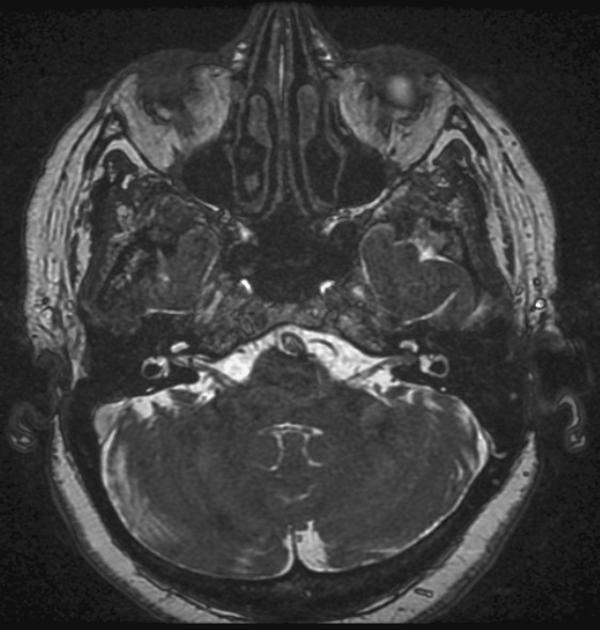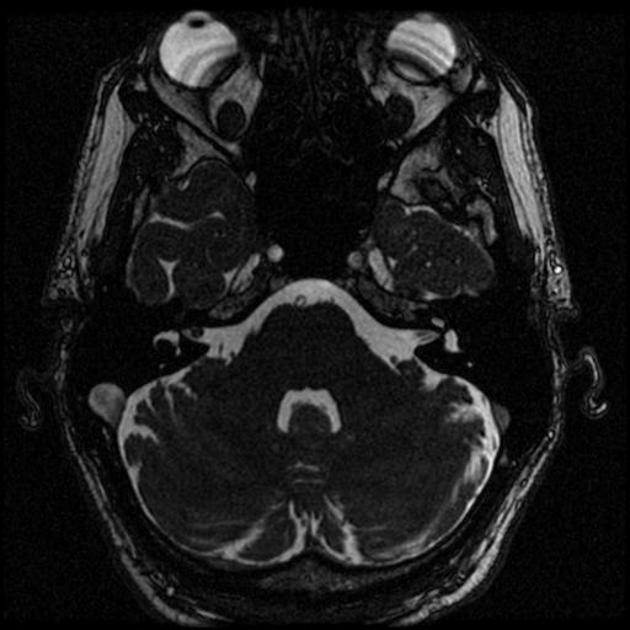Acoustic neuroma MRI
|
Acoustic neuroma Microchapters | |
|
Diagnosis | |
|---|---|
|
Treatment | |
|
Case Studies | |
|
Acoustic neuroma MRI On the Web | |
|
American Roentgen Ray Society Images of Acoustic neuroma MRI | |
Editor-In-Chief: C. Michael Gibson, M.S., M.D. [1]Associate Editor(s)-in-Chief: Simrat Sarai, M.D. [2]
Overview
Gadolinium-enhanced MRI scan is diagnostic of Acoutic neuroma. On brain MRI, glioblastoma is characterized by hypointense mass on T1-weighted MRI and hyperintense mass on T2-weighted MRI
MRI
Magnetic resonance imaging (MRI) using Gadolinium as an enhancing contrast material is the preferred diagnostic test for identifying acoustic neuromas. The image formed clearly defines an acoustic neuroma if it is present and this technique can identify tumors measuring only a few millimeters in diameter. Tumors as small as 1-2 mm in diameter can be demonstrated by well performed MRI scanning. Nonenhanced MRI can miss small tumors.[1]
Most vestibular schwannomas have an intracanalicular component, and often result in widening of the porus acusticus resulting in the trumpeted IAM sign, which is present in up to 90% of cases. In a minority of cases (~20%) they are purely extracanalicular, only abutting the porus acousticus. Usually there is a small CSF cap between intracanalicular portion and the cochlea; occasionally, these tumours grow laterally through the cochlea (transmodiolar) or vestibule (transmacular) into the middle ear. Rarely they are small and confined to the vestibule (intravestibular) or to the cochlea (intracochlear) or both (vestibulocochlear). Extracanalicular extension into cerebellopontine angle (path of least resistance) can lead to "ice-cream-cone" appearance. Small tumours tend to be solid whereas cystic degeneration seen commonly in larger tumours. Haemorrhagic areas may also be seen. Calcification is typically not present.[2]
| MRI component | Features |
|---|---|
|
|
|
|
|
|
Post-up MRI:Linear enhancement may not indicate tumour, but if there is nodular enhancement suspect tumour recurrence (needs follow up MRI). [3]


References
- ↑ "Wikipedia acoustic neuroma diagnosis".
- ↑ "Radiopedia acoustic neuroma radiographic features".
- ↑ "Radiopedia acoustic neuroma radiographic features".
- ↑ Image courtesy of Dr Frank Gaillard. Radiopaedia (original file here).[http://radiopaedia.org/licence Creative Commons BY-SA-NC
- ↑ Image courtesy of Dr. Roberto Schubert Radiopaedia (original file here).[http://radiopaedia.org/licence Creative Commons BY-SA-NC